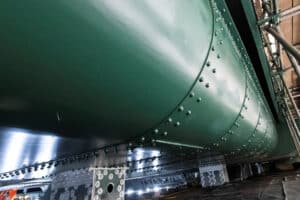Revitalising an icon
The first section of new green paint has been revealed on the Tyne Bridge, marking a momentous day in the major restoration programme.
The Tyne Bridge is a through-arch bridge over the River Tyne in North East England, linking Newcastle upon Tyne and Gateshead. The bridge was designed by the engineering firm Mott, Hay and Anderson, which later designed the Forth Road Bridge, and was built by Dorman Long and Co of Middlesbrough, which later built the Sydney Harbour Bridge. These bridges derived their design from the Hell Gate Bridge in New York City.
The bridge was officially opened on 10 October 1928 by King George V and has since become a defining symbol of Tyneside.
Repair work
Within the encapsulated scaffold adjacent to the Gateshead tower, the steelwork has been cleaned before being grit-blasted to remove over 96 years of previous paint coatings, including lead-based paint.
Steelwork repairs have been undertaken and the application of the new three-coat paint system is well underway, with the first section of green paint on the parapet and underside of the bridge deck now complete.
Due to the bridge’s Grade II listed status, the paint colour being used is a British Standard 4800 colour referenced 14C39 called ‘Hollybush’. This is as close to the original colour as possible.

The paint colour being used is a British Standard 4800 colour referenced 14C39 called ‘Hollybush’
The new paint system has been chosen for its durability, UV resistance, protective and colour retention qualities and its resistance to the harsh atmospheric environment of the bridge, sitting above a tidal river and subject to the winds of the Tyne Valley gorge. It should give protection to the bridge for the next 30 years before major repainting is required.
The scaffolding around the Gateshead tower was gradually dismantled, and the public can now see the major transformation that has taken place. At the same time, the scaffold around the Newcastle tower will continue to rise, with tunnels for vehicle traffic, pedestrians and cyclists already in place to keep access to the busy Quayside area open while the restoration work progresses above.
Read more of this article in the latest issue of Protective Coatings Expert

